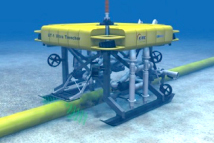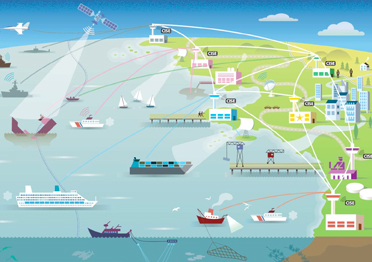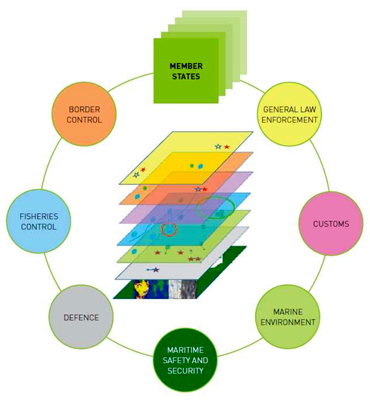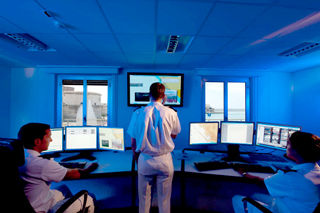An overview of EOS’ focus on the current EUROSUR and CISE initiatives, and how they could fit into a more comprehensive approach on Integrated Maritime Surveillance (IMS), which could accommodate a new concept and business model: ‘The Internet of the Sea’ and the ‘Blue Economy’
by the European Organisation for Security (EOS)
 A myriad of initiatives, project and activities relevant to maritime surveillance exist with differing objectives, such as policies for the control of the EU’s external maritime borders, the maritime transport of goods and people, the security of maritime transport, supply chain security, R&D, certification and standardization activities for maritime surveillance technologies and solutions.
A myriad of initiatives, project and activities relevant to maritime surveillance exist with differing objectives, such as policies for the control of the EU’s external maritime borders, the maritime transport of goods and people, the security of maritime transport, supply chain security, R&D, certification and standardization activities for maritime surveillance technologies and solutions.
These initiatives are owned by a diversity of actors (not necessarily acting in full coordination with each other), such as DG MARE, DG MOVE, DG HOME, DG TAXUD, DG ENTR, DG JRC, FRONTEX, EMSA, the European Committee for Standardization (CEN), and the different EU Member States. This state of affairs is not sufficiently efficient.
A more comprehensive and harmonized European approach would instead be more effective, ensuring that available resources are spent with higher efficiency and that policies and activities are more strongly correlated and better coordinated. This would avoid unnecessary overlaps, duplications and waste of resources, and hence be more conducive to interoperability and a better business environment that facilitates economic growth. It would also increase the synergies between the different ongoing EU policies in this sector.
Integrated maritime surveillance
Increased focus on security and sustainability issues to better fight crime and irregular immigration, enhance interoperability, which would translate into a more efficient and effective spending of resources and create a better business environment that offers new market opportunities in line with the EU’s EUROPE 2020 policy. The European Union and its Member States should put in place an Integrated Maritime Surveillance (IMS) approach.
Such an IMS would consider:
- improve coordination and wider implementation of EUROSUR, also as a building block of the CISE.
- implement the CISE platform,
- create an “Internet of the SEA” with services and applications leveraging on the CISE and enlarging the latter’s functionality.
Indeed, it would be more effective, from the point of view of implementation and operation costs, to consider the links between EUROSUR (including its possible extension to wider basins) and CISE (including its possible extension to a wider range of economically viable and sustainable services) in a comprehensive top down approach for an IMS in detail from the beginning of their design and implementation to facilitate the growth of a strong Single European Market for Integrated Maritime Surveillance.
CISE
CISE does not directly address the border security aspects of maritime surveillance, but leaves them to EUROSUR, which would provide a sound information background. A more comprehensive top down approach would be better suited for the efficient implementation of EUROSUR in a wide and comprehensive European IMS as envisaged by the CISE.
Indeed, only a top down approach can develop and implement a consistent functional architecture, standards and procedures that allow for a high degree of interoperability for the whole maritime surveillance sector. The implementation of a top down approach should be supported by a wider dialogue between the Member States, Frontex, the European institutions and the industry at large, where the private sector should be allowed to benefit from the CISE infrastructure in order to bring CISE up to its potential.
Unfortunately according to the formal definition of the CISE Roadmap, only public sector “authorities”, defined by Member States, can collect, share and use data and information under certain conditions. While these conditions are understandable, the private sector should play a stronger role at the earliest. Users, operators, suppliers of technology and services could be important contributors to an efficient set up of the systems now, and to the secure exchange and use of the information in advanced services in the future. Economic operators and solution suppliers could well support the evolution of the network and help build up an effective and economically viable Partnership.
 A wider public-private exchange of information could create additional services thanks to the use of the CISE information, data or an aggregation thereof, and the partnership could open up the CISE benefits to a variety of areas, such as: maritime safety, vessel traffic management, maritime security, maritime customs activities, the prevention and suppression of trafficking and smuggling, maritime law enforcement, maritime border control, maritime surveillance, maritime environmental protection and response, search and rescue, accident and disaster response, fisheries control and many more. In a very ambitious sense, this could even go so far as to create and “Internet of the Sea”.
A wider public-private exchange of information could create additional services thanks to the use of the CISE information, data or an aggregation thereof, and the partnership could open up the CISE benefits to a variety of areas, such as: maritime safety, vessel traffic management, maritime security, maritime customs activities, the prevention and suppression of trafficking and smuggling, maritime law enforcement, maritime border control, maritime surveillance, maritime environmental protection and response, search and rescue, accident and disaster response, fisheries control and many more. In a very ambitious sense, this could even go so far as to create and “Internet of the Sea”.
Internet of the Sea
 The CISE functionality could be extended in a way to lay the groundwork for the creation of an “Internet of the Sea”. Such an Internet of the Sea would use CISE as an information infrastructure and allow for the secure exchange of data and information. It would rely on CISE’s data aggregation functionality and likely on general Cloud applications. Such an initiative would create opportunities for the development and exploitation of services that are economic viable or of societal importance, beyond the presently envisaged services limited to the public administrations, by allowing for the use of the CISE data and information for specific professional services that revolve around maritime surveillance.
The CISE functionality could be extended in a way to lay the groundwork for the creation of an “Internet of the Sea”. Such an Internet of the Sea would use CISE as an information infrastructure and allow for the secure exchange of data and information. It would rely on CISE’s data aggregation functionality and likely on general Cloud applications. Such an initiative would create opportunities for the development and exploitation of services that are economic viable or of societal importance, beyond the presently envisaged services limited to the public administrations, by allowing for the use of the CISE data and information for specific professional services that revolve around maritime surveillance.
In addition to the creation of new business opportunities and models, the Internet of the Sea would incentivise the continuous improvement of the CISE platform of sensors that provide the data (similarly as the Internet is constantly growing with the introduction of more powerful servers).
New services will require new infrastructure, hence stimulating related research as well as the European economy.
EUROSUR
A fast EUROSUR’s deployment is needed considering the important societal and economic threats linked to border surveillance. Many implementation activities are ongoing but not always in clear coordination between the public and the private sectors. The current bottom-up approach might allow for an easier acceptance by Member States of the EUROSUR architecture in the short term. Yet it creates too much fragmentation which severely impacts the development of effective and competitive solution in the long term.
A top-down approach is actually under discussion in the proposed EUROSUR regulation1 which is expected to enter into force October 2013: this could well provide a positive answer to this issue. At present, the current bilateral dialogue between Frontex and single industries, or with those in charge of research projects is, in our opinion, still insufficient. This approach could be unable to deliver implementation guidelines or a full and proper assessment of available operational solutions. The fact that a sufficiently clear industrial roadmap that matches the political one is still missing, could limit the operations and cost efficiency of EUROSUR in the future. Finally, the development of EUROSUR should take further evolution into account. Beyond its mission objectives of intercepting criminals and irregular migrants at sea, EUROSUR could have much potential to support the EUROPE 2020 objectives of job creation and economic growth as well as taking in better consideration the Civilian / Military issues linked to Maritime Surveillance.
- For EUROSUR to finally become operational and to provide true EU added value, the European Security Industry recommends (some of these suggestions are today under discussion in the proposed EUROSUR regulation) to:
- substitute the current bottom-up approach with a more top-down approach supported by a public-private dialogue that guarantees a harmonisation of the EUROSUR elements in coordination with Member States procurement bodies and FRONTEX
- harmonise EUROSUR’s concepts of operation and needs for the implementation at the national level
- promote standards, and put in place certified and interoperable solutions as well as optimised procurement procedures that make the best use of available resources
- enlarge EUROSUR as soon as possible to a wider basin approach that extends to third countries. This approach should be implemented by leveraging support of EU external funds
- urgently develop an industrially viable Roadmap with clear milestones and resources adequate to implement it, supporting the political Roadmap for EUROSUR and CISE to limit implementation and operational costs and support sustainability and competitiveness of EU solutions
- let FRONTEX pilot certification through the coordination of national testing facilities, with the support of the ERNCIP project, and to let FRONTEX directly undertake procurement activities where needed
- use EUROSUR as a showcase for the global export of European products and competence, hence creating jobs and economic growth in the European homebase.
SEA4All mechanism
To efficiently develop a comprehensive approach for an Integrated Maritime Surveillance as described here, a specific coordination and planning mechanism should be set up: the SEA4ALL. It is suggested that SEA4ALL be a European Programme, likely in the form of a European Innovation Partnership. This would provide for the efficient governance of objectives and resources for the deployment of and extended EUROSUR and CISE, and the creation of the mentioned “Internet of the Sea”. It should include the stakeholders of all relevant areas in a public-private dialogue and cooperation, such as security, safety, environment, and the economy at large.
Blue economy
This would largely contribute to the EU “Blue Economy” and an even wider impact on growth and jobs as requested by the EUROPE 2020 policy. The public-private dialogue would link all relevant groups of experts currently working on the different maritime surveillance initiatives: the CISE TAG composed of Member States Experts, the EUROSUR Expert Group composed of Member States, the Implementation Working Group composed of DG ENTR project coordinators, and the private sector (not only at R&D level, but also at business development level for higher commitment to market deployment of solutions).
This stronger coordination of the private sector could be provided by the EOS Integrated Maritime Surveillance Advisory Group which could include, if needed, also other key private sector stakeholders for larger representativeness.



